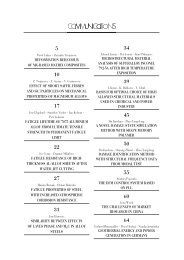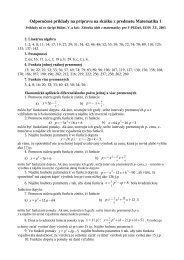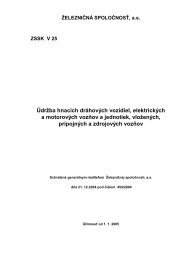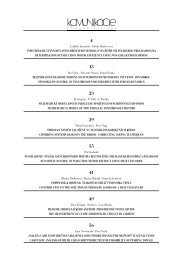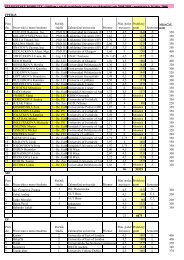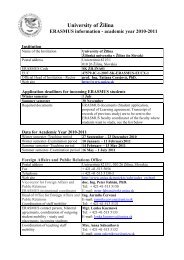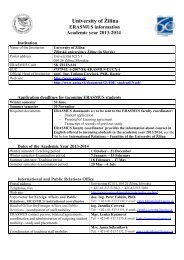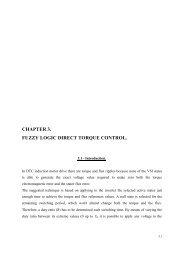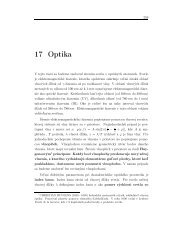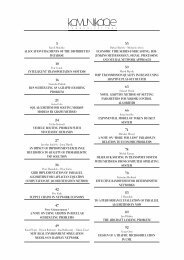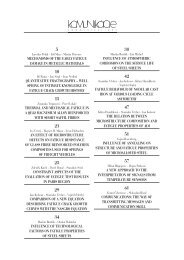3. Intermodal trainsIntermodal trains are taken as a system <strong>of</strong> fast train connections<strong>of</strong> intermodal transport (hereinafter as IMT) which ensuresconnection among individual IMT terminals in desired quality andsufficient volume <strong>of</strong> transported goods. Systems <strong>of</strong> through trainsand mixed trains are used for <strong>the</strong> train connection among IMT terminals.From <strong>the</strong> <strong>railway</strong> carrier’s point <strong>of</strong> view <strong>the</strong> whole cargo(transport unit) is transported ei<strong>the</strong>r as an individual <strong>set</strong> <strong>of</strong> coachesor as a group <strong>of</strong> <strong>set</strong>s <strong>of</strong> coaches or as <strong>the</strong> shuttle train. The biggestshare <strong>of</strong> IMT cargos is transported in <strong>the</strong> shuttle trains which allbelong to <strong>the</strong> “Nex” train c<strong>at</strong>egory.Heinrici [11] found th<strong>at</strong> <strong>the</strong> systems <strong>of</strong> train connections <strong>of</strong>IMT transport units can be oper<strong>at</strong>ed on an individual line or ona specified line network. In <strong>the</strong> former case we speak <strong>of</strong> so-called“line system” and in <strong>the</strong> l<strong>at</strong>ter case we speak <strong>of</strong> <strong>the</strong> so-called“network system”.The network system <strong>of</strong> train connections is characterized asa network service <strong>of</strong> individual terminals on a specified trafficnetwork. This means th<strong>at</strong> <strong>the</strong>re is a gap in <strong>the</strong> service <strong>of</strong> individualIMT terminals using line systems which are included in <strong>the</strong> trafficnetwork. A system <strong>of</strong> shuttle trains connecting <strong>the</strong> individual IMTterminals is usually used in <strong>the</strong> network system. This networksystem is in <strong>the</strong> IMT area represented by <strong>the</strong> “Hub-and-Spoke”system, as described by Novak [21].this technology is used mainly abroad. For example, in Germany(IMT oper<strong>at</strong>or Kombiverkehr) this system is represented as <strong>the</strong>“goods IC-concept”. It is a very similar system to <strong>the</strong> one used bypassenger trains IC, ICE and EC c<strong>at</strong>egories, as described byHeinrici [11].A practical applic<strong>at</strong>ion <strong>of</strong> this technology has been found notonly abroad but also in <strong>the</strong> Czech Republic. Especially in transport<strong>at</strong>ionamong seaports (Rotterdam, Bremerhaven, Hamburg)and some inland terminals (Praha-Uhrineves, Melník, Lovosice)th<strong>at</strong> have <strong>the</strong> position <strong>of</strong> node terminals. In <strong>the</strong>se lines <strong>the</strong> freighttraffic volumes are high and <strong>the</strong> trains are usually <strong>set</strong> out twice perday (24 hours). In o<strong>the</strong>r sequential directions (o<strong>the</strong>r terminals in<strong>the</strong> CR or adjacent countries) <strong>the</strong> freight traffic volumes are muchlower and <strong>the</strong> train <strong>set</strong>-out frequency is much lower (2 to 5 trainsper week).4. Train routes model for intermodal trainsThe task <strong>of</strong> any transport problem solved by a m<strong>at</strong>hem<strong>at</strong>icmodel is finding its <strong>at</strong>tributes, analysing all its st<strong>at</strong>es and verifyingits scheduled parameters. This is subjected to right definition anddimensioning <strong>of</strong> system items, efficient regul<strong>at</strong>ion and organiz<strong>at</strong>ion<strong>of</strong> <strong>the</strong> system.4.1 General solutionIn <strong>the</strong> node terminal two groups <strong>of</strong> shipments are assembledfor one train. Cerna [4] and Janacek [13] suggest th<strong>at</strong> in <strong>the</strong> firstgroup are shipments which enter <strong>the</strong> system in th<strong>at</strong> node. Thesecond group are shipments which came into th<strong>at</strong> node by train.If <strong>the</strong>re is a node u in time t ij (arrival time <strong>of</strong> train j on line i) , <strong>the</strong>shipment will be brought by train sij on train p<strong>at</strong>h L i , will bereloaded for time l (time <strong>of</strong> reload from line i to lane r) to positionon train p<strong>at</strong>h L r and will wait for <strong>the</strong> nearest train s rg <strong>of</strong> th<strong>at</strong>train p<strong>at</strong>h with <strong>the</strong> depart <strong>at</strong> time t rg (departure time <strong>of</strong> train g online r):trg $ tij + tirl[min] (1)Providing th<strong>at</strong> <strong>the</strong> train s ij departs from a starting st<strong>at</strong>ion <strong>at</strong>time t o ij and th<strong>at</strong> <strong>the</strong> travelling time to node u is d u ij <strong>the</strong>n <strong>the</strong> arrivaltime to t ij can be formularized by 2 and 3:t ijo= t + dijuij[min] (2)Fig. 1 Logistic technology „Hub-and-Spoke“and for <strong>the</strong> train s rg :t rgo= t + drgurg[min] (3)The “Hub-and-Spoke” technology can be combined with <strong>the</strong>line principle using <strong>the</strong> technology <strong>of</strong> multiple-section trains. Theschem<strong>at</strong>ic represent<strong>at</strong>ion <strong>of</strong> this technology is in Fig. 1. Novak[21] and Vrenken [26] found th<strong>at</strong> <strong>the</strong> network structure based onBlackout time during waiting for reload can be formularizedby 4:o o u ut = t - t + d -d -tlczrgijrgijir[min] (4)20 ● COMMUNICATIONS 3/2008
If we are unable to influence <strong>the</strong> last three timing logic elementsth<strong>at</strong> means th<strong>at</strong> <strong>the</strong> travelling times <strong>of</strong> each train are dij u anddrg u and reloading time is l. Then we can lower <strong>the</strong> blackout timeby increasing <strong>the</strong> value <strong>of</strong> tij o to:ox ot = t + xijor by lowering t o rg value to:ox ot = t + x ; _ x 0irg[min] (5)Now we can extend <strong>the</strong> formula (1) to:ou out + x + d -t -x -d -tl0rgijrgrg[min] (6)Besides <strong>the</strong> boundary conditions like (7) <strong>the</strong>re is also ano<strong>the</strong>rone which ensures time loc<strong>at</strong>ions <strong>of</strong> trains s ij . It may vary in fixedbounds (a ij , b ij ):a # t + x # bij ij ij ijSimilarly for trains s rg :a # t + x # brg rg rg rgRoutes L i and L r pass through <strong>the</strong> node u and two lines <strong>of</strong>those routes s ij and s rg are coordin<strong>at</strong>ed if <strong>the</strong>re exist two numbersx ij and x rg , which fulfil conditions (8) and (9). So we can makea directed graph G (S, H), where (s ij , s rg ) ∈ H if node u existswe are able to coordin<strong>at</strong>e those lines (S – <strong>set</strong> <strong>of</strong> routes, H – coordin<strong>at</strong>edgraph <strong>of</strong> transport network). The edges determine h ∈ Hwhich pairs <strong>of</strong> nodes can be coordin<strong>at</strong>ed but not all <strong>of</strong> <strong>the</strong> pairsfrom <strong>the</strong> <strong>set</strong> H can be coordin<strong>at</strong>ed simultaneously by a differentvalue <strong>of</strong> x ij . Therefore, a coordin<strong>at</strong>ed subgraph G(S, H) mustbe found where for all i 1, … n, j 1, … m i exist values x ij fulfilling<strong>the</strong> condition (7).For <strong>the</strong> coordin<strong>at</strong>ed subgraph G <strong>the</strong>re exist usually more possibilitiesfor <strong>the</strong> x ij value, which comply with each pair <strong>of</strong> nodes(x ij , x rg ) ∈ H conditions (7) and (8). The selection <strong>of</strong> final valuewill depend on <strong>the</strong> consignment volume f ir , which will be reloadedin a node from L i to L r . Here we establish a term optimal solutionfor coordin<strong>at</strong>ed pairs <strong>of</strong> trains. It is determined by <strong>the</strong> subgraphG:X = # x ij -; = 1,… ; = 1,…(7)(8)(9), (10)for i, j which comply with condition (8), for all (x ij , x rg ) ∈ H andcondition (7) and which minimize <strong>the</strong> value <strong>of</strong> <strong>the</strong> objective functionur :/ou ouur= f _ t + x + d -t -x -d -tliir_ sij,srgiijrg rg 1rgrgijrgijrg(11)If we expect th<strong>at</strong> <strong>the</strong> values t o , d u , t are constant according to<strong>the</strong> optimiz<strong>at</strong>ion task <strong>the</strong> value <strong>of</strong> objective function ur is minimizedafter fulfilling above mentioned conditions:ijijir $ijijir/ur= f _ x -xiir rg ij_ sij,srgi! Hl(12)The resultant form <strong>of</strong> objective function depends on subtraction<strong>of</strong> values x ij and x rg which are additional times to arrival <strong>of</strong>a train on a train route t ij or departure <strong>of</strong> a train on a train routet rg . So if we want to <strong>set</strong> up <strong>the</strong> objective function for <strong>the</strong> train routemodel we have to come out from <strong>the</strong> formula (12) as described byCaprara [3] and Cerna [4].4.2 Formul<strong>at</strong>ion <strong>of</strong> a m<strong>at</strong>hem<strong>at</strong>ical modelRailroad timetable <strong>set</strong> up is an intensive and long process. Thereason is in a limited use <strong>of</strong> a computer applic<strong>at</strong>ion. It is mainly aninteractive process between human experiences and autom<strong>at</strong>edgener<strong>at</strong>ion <strong>of</strong> timetable tools. Kryze [18] and Nielsen [20] suggestth<strong>at</strong> <strong>the</strong> whole travelling time for a consignment in intermodaltransport contains <strong>the</strong>se components:● Travelling times between terminals,● Time spent <strong>at</strong> stops on <strong>the</strong> train route,● Waiting time (result <strong>of</strong> insufficient capacity <strong>of</strong> oper<strong>at</strong>ion equipment),● Synchroniz<strong>at</strong>ion time (time needed to reload consignmentsbetween two trains).Shortening <strong>of</strong> first three times (travelling time, time spendand waiting time) is subjected to investments (<strong>of</strong> infrastructure).On <strong>the</strong> contrary, synchroniz<strong>at</strong>ion time is determined by timetableso th<strong>at</strong> we are able to shorten <strong>the</strong> synchroniz<strong>at</strong>ion time only bychange <strong>of</strong> organiz<strong>at</strong>ional <strong>set</strong>-up (non-investment character). Thereforeit would be better to work on optimiz<strong>at</strong>ion leading to minimiz<strong>at</strong>ion<strong>of</strong> synchroniz<strong>at</strong>ion time, as described by Dirmeier [6].In railroad cargo transport <strong>the</strong>re exist two types <strong>of</strong> synchroniz<strong>at</strong>ion:1. Waiting <strong>of</strong> train due to unloading <strong>of</strong> goods.During this first type <strong>of</strong> synchroniz<strong>at</strong>ion <strong>the</strong>re is an extendedtravelling time for goods due to unloading, and <strong>the</strong>refore <strong>the</strong>reis no advantage from synchronized times.2. Waiting <strong>of</strong> goods for connecting trainIn <strong>the</strong> second form is extended travelling time <strong>of</strong> goods whichneeds synchroniz<strong>at</strong>ion.Reloading process (form<strong>at</strong>ion <strong>of</strong> synchroniz<strong>at</strong>ion time principle)<strong>of</strong> transport units between two trains is in Fig. 2. From th<strong>at</strong>figure it follows th<strong>at</strong> <strong>the</strong> waiting time has several significant spells.Those spells are due to shipping and traffic reasons. The mostimportant part is synchroniz<strong>at</strong>ion time which depends on a minimalreloading time. Waiting time is a result <strong>of</strong> insufficient capacity <strong>of</strong>railroad infrastructure or insufficient locomotives. This time maynot apply to each train. The size <strong>of</strong> th<strong>at</strong> time is variable for differentgroups <strong>of</strong> trains. On <strong>the</strong> o<strong>the</strong>r hand, stopping time and timefor disp<strong>at</strong>ch <strong>of</strong> a train must be kept to a minimum for each train.In Fig. 2, we can see a striking difference between <strong>the</strong> waiting time<strong>of</strong> “not-reloaded” consignments in <strong>the</strong> first or second train and <strong>the</strong>waiting <strong>of</strong> reloaded consignments between those trains. Th<strong>at</strong> canbe applied also for more than two trains in a st<strong>at</strong>ion.COMMUNICATIONS 3/2008 ●21
- Page 5 and 6: Mt = k$ Di(12) 4. Torsion moment at
- Page 7: References[1] JOVANOVIC, R.: Tensio
- Page 10 and 11: Fig. 3 Geometrical parameters of ch
- Page 12 and 13: Fig. 13 10. eigenvector when the ei
- Page 14 and 15: and D R _ y,wi=0 if y 0 (12) Dampe
- Page 16 and 17: Fig. 22 Comfort for passengers for
- Page 20 and 21: Fig. 2 Consignment reloading proces
- Page 22 and 23: attached to individual tracks shown
- Page 24 and 25: Juraj Gerlici - Tomas Lack *MODIFIE
- Page 26 and 27: After the insertion of the previous
- Page 28 and 29: where:k - is the basic spring stiff
- Page 30 and 31: [2] GERLICI, J., LACK, T.: Methods
- Page 32 and 33: Resulting from experience the degre
- Page 34 and 35: Upon this strengthening of pretensi
- Page 36 and 37: attained the 6th position of the be
- Page 38 and 39: Jozef Jandacka - Stefan Papucik - V
- Page 40 and 41: spacing of the fan from the measuri
- Page 42 and 43: 5. ConclusionFrom the results prese
- Page 44 and 45: REVIEWlines with numerous curves th
- Page 46 and 47: REVIEWmeters from the point of view
- Page 48 and 49: REVIEWBojan Cene - Aleksandar Rados
- Page 50: REVIEWthe year 2006 in Slovenia sta
- Page 53 and 54: REVIEWthat the GPS does not recogni
- Page 55 and 56: REVIEWRadomir Brkic - Zivoslav Adam
- Page 57 and 58: REVIEWfailures. For example, for an
- Page 59 and 60: REVIEWJan Krmela *COMPUTATIONAL MOD
- Page 61 and 62: REVIEWFor this reason tyres and whe
- Page 63 and 64: REVIEWFig. 6 Computational model
- Page 65 and 66: REVIEW- guarantee that the messages
- Page 67 and 68: REVIEWIvana Olivkova *PASSENGER INF
- Page 69 and 70:
REVIEWLike the other information sy
- Page 71 and 72:
REVIEWFig. 1 Revolution of the poin
- Page 73 and 74:
REVIEWFig. 4 Transformation of the
- Page 75 and 76:
BOOK REVIEWKavicka, A., Klima, V.,



